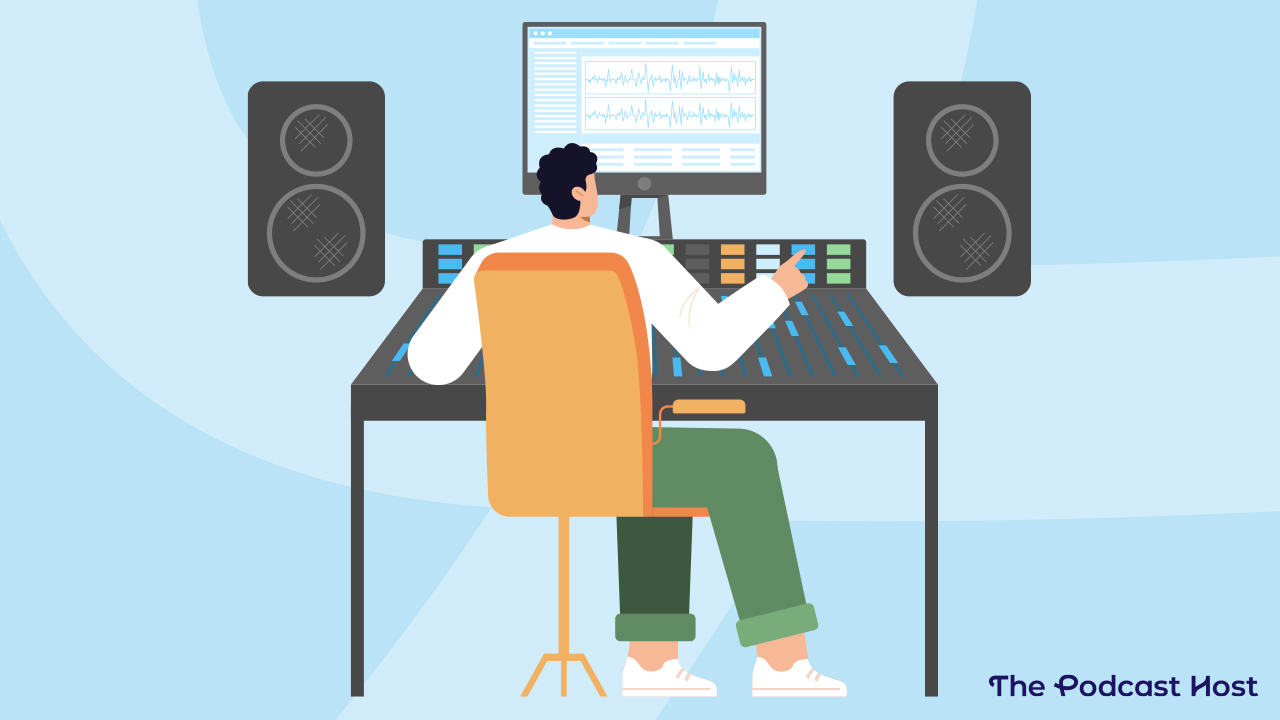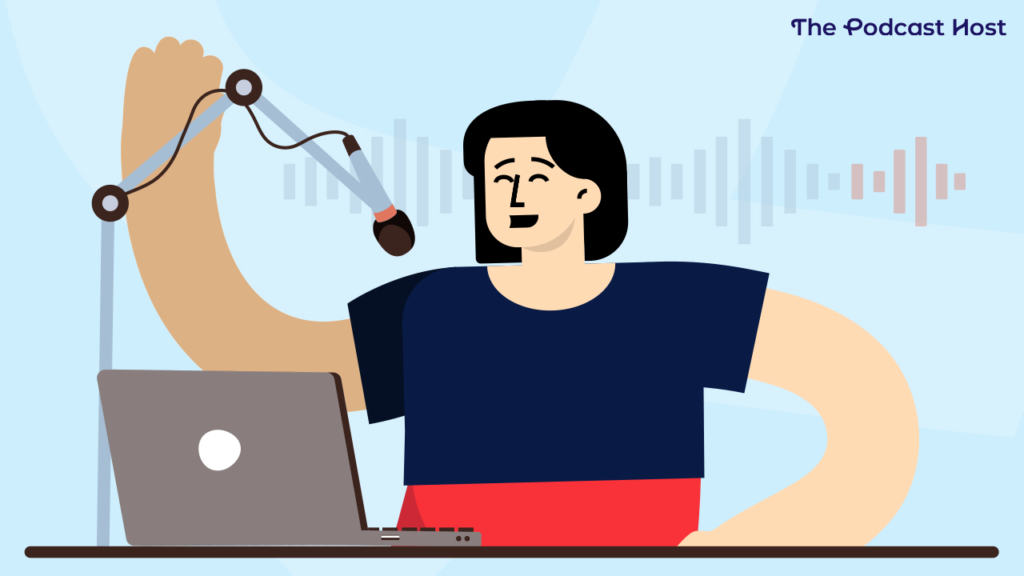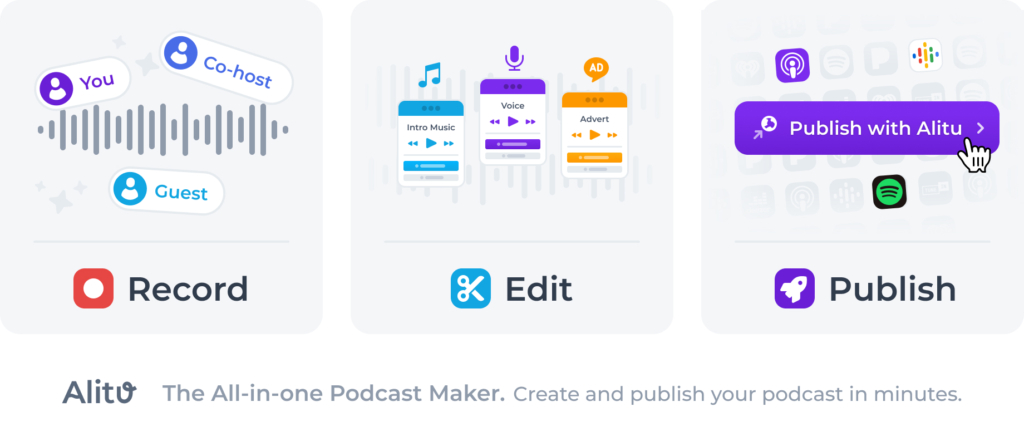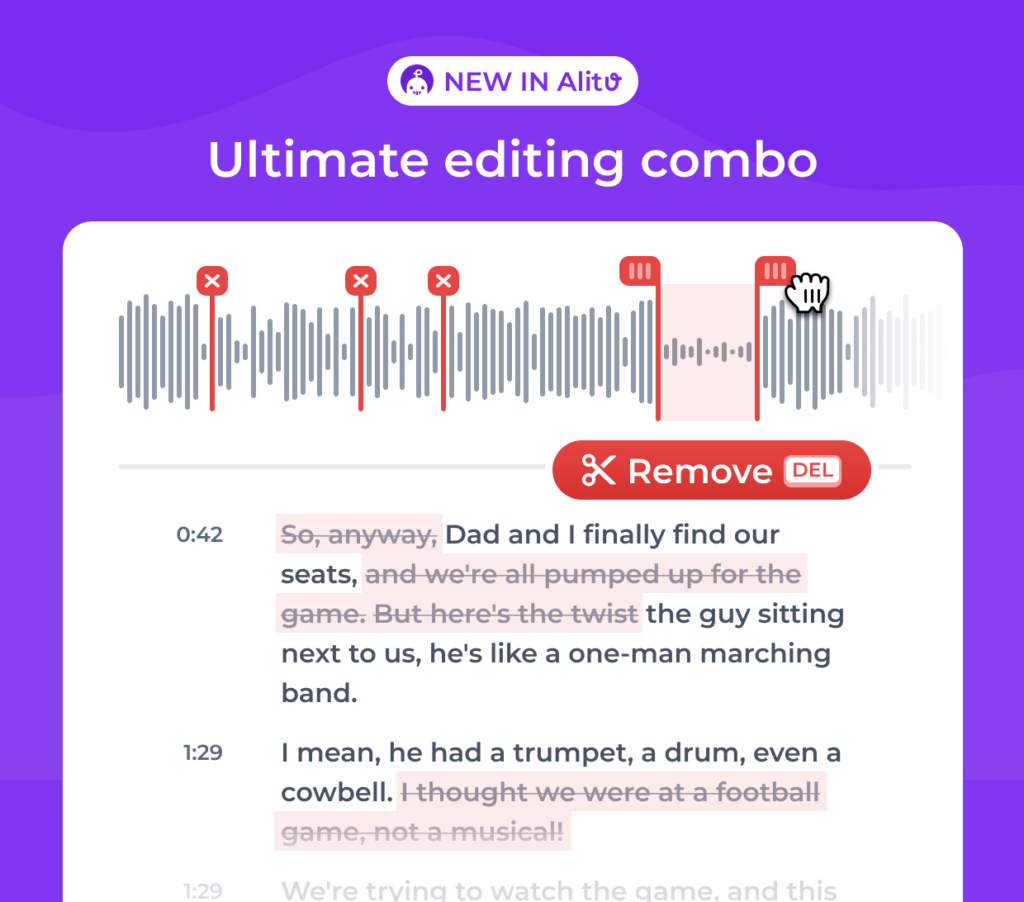How to Record a Podcast (It’s Easier Than You Think!)

This is it: time to record a podcast, and there’s more to it than simply hitting the “record” button. Fortunately, not that much more to it, though. Recording a podcast can be a pretty easy process when you know how. And after reading this guide, you will!
With that in mind, here’s a quick summary of how to record a podcast. Let’s break it down into three main parts:
- Planning: what prep do you need to do so that the recording goes smoothly?
- Equipment: what gear do you need to be able to record a great quality show?
- Software: what tools do you need to be able to capture your audio?
By the end of this article, you’ll know everything you need to record a podcast. All that’s left is to hit that big red button, and get your voice out into the world!
Planning to Record a Podcast
It’s tempting to miss this bit out… You know the subject, after all, and you’re raring to go! Why not just wing it?
Well, as much as I’m a fan of the seat-of-the-pants approach, an episode plan can make a huge difference to the quality of your show. Don’t worry; this doesn’t need to take up your whole day. A small plan can make a big difference.
Plan the Topic
First thing, what are you going to talk about? This is the gold. If you choose the wrong episode topic, then your $500 Heil mic and your pro-level Zoom H6 recorder don’t matter a whit. Listeners won’t care about the show, perfect audio quality or not.
So, do your research. Figure out your ideal listener, and particularly what they care about. Then, for each episode, think:
- What questions are your listeners asking?
- What problems are they experiencing?
- What are they struggling with right now?
For every episode, you should tackle one of them.
How do you figure that out? Good old-fashioned keyword research, tailored for podcasting. Check out that article for a full rundown of tools that can help you find a bunch of questions that you can answer.
You can also use a tool called the Alitu Showplanner to generate episode ideas (along with potential podcast names, an elevator pitch, suggested formats, an ideal audience profile, a trailer script, and ideas to make your show unique!). It’s totally free, no signup or login required.
Finally, if you’re into physical notebooks or journals, too, then you might fancy getting yourself a copy of The Podcast Host Planner. This journal helps you plan out everything – from big-picture goals to individual edit timecodes. It acts as a great tangible reminder that you take podcasting seriously.
Script the Episode
Scripting is an oft-debated topic. Should you go super-detailed, or might you go quite light and off-the-cuff? I answered that in a full article on how to script a podcast with a few examples. But let’s cover it in brief.
On the one hand, a detailed script can make for a really tight, value-packed episode. It cuts the rambling and ensures you cover every single thing you need to.
The only trouble is that a detailed script can cut the spontaneity and drain your personality from an episode. It does take quite a bit of skill to read a detailed script and still sound natural and conversational. But it’s possible.
Plus, of course, it takes quite a lot of time to put together something so detailed.
On the other hand, a light script – just a collection of bullet points, really – can provide enough guidance, but not tie you down. You can be more engaging, more free-flowing, and more personable, and it takes much less time to prepare.
But, again, the downsides… with a light-touch script, you can much more easily lose your way, forget things and repeat yourself. The waffle factor increases dramatically, and your episodes will tend to be longer. That’s not necessarily a good thing…
It often comes down to personality and practice. Start with a detailed script until you get more comfortable on the mic. Then, reduce the detail, bit by bit, until you find that balance between time spent, benefits gained and recording style.
What Equipment Do I Need to Record a Podcast?
You could have the best topic and plan in the world, but without the equipment needed to record a podcast, it’s all just going to remain at the ideas stage. So what do you need?
You Need a Microphone
First, let’s capture that voice. That’s what the humble microphone is designed to do. You can find a collection of the best microphones here, so have a browse through and pick something that fits your space and budget.
If you want to keep things simple, go for a USB microphone. You’ll plug that right into your computer and record there. No other equipment needed, just software. I’ll cover the recording software below, too.
A USB mic is ideal for anyone who’ll be recording a solo show, or if you’ll be recording with others over the internet (more on software for this below, too). And, let’s be honest, that’s 90% of the podcasts out there!
Our favourite (and most recommended) mic is the Samson Q2U. It’s a very affordable piece of kit which works in both USB and XLR form. Check out our full review of the Samson Q2U if you’re in the market for a microphone.
Do You Need a Digital Recorder?
If you think you’ll be recording a podcast with others in person, though, a digital recorder comes in handy. It’s tricky to record with more than one USB mic on a single computer.
In this case, the ideal setup is one digital recorder and two (or more!) XLR microphones. For example, I use a Zoom H5 and two Samson Q2Us in this way.
For another cracking option, the Zoom PodTrak P4 is a dedicated podcast recorder. It lets you record multiple mics and remote calls (online and phone), as well as play live music, clips, and effects in your episodes. Check out our full review of the Zoom PodTrak P4 to get the lowdown.

How About a USB Audio Interface?
An audio interface is something of a middle ground between a USB mic and a digital recorder. A USB audio interface connects to your computer like a USB mic, but you plug in and run XLR mics into it. This is a great option for computer-based podcasters who want to improve their audio quality whilst increasing their range of flexibility and control. Here are the Best USB Audio Interfaces for Podcasters.
Do I Need Any Other Podcast Recording Gear?
If you opt for a USB mic, then a cable will always be included in the box. If you’re going XLR and running into a digital recorder or USB interface, you’ll need an XLR cable for each mic you use. Sometimes XLR cables come with mics, but it’s good practice to have a spare one kicking around anyway. You can pick up a decent one for less than $20. Check out our complete guide to audio cables for more on that.
Elsewhere, you might want to mount your mic on a boom arm for more flexibility and a better all-round feeling of professionalism. You’ll also definitely want to use headphones for recording your podcast. A simple pair of earbuds will do the trick, but investing in a great pair of podcast headphones costs much less than you think.
Would You Like to Record on a Smartphone?
For solo recording or a two-person interview, an option I really like is the Rode Smartlav+. This is a lavalier mic (tie mic or lapel mic – those wee ones you see clipped to a presenter’s shirt on TV!), and it plugs right into your smartphone.
If you add a Rode AI Micro adapter to this setup, you can plug in two Smartlavs and record an interview with someone right next to you! See the whole Smartlav interview setup here if you think this might suit you.
And that concludes our whirlwind tour of the gear needed to record a podcast. But be sure to check out our Best Podcast Equipment guide if you’d like to do a bit more shopping around on this front.
What About My Podcast Recording Studio or Environment?
Good question! You can employ the best gear and software in the world, but if you’re using them in a sub-par environment, your podcast will sound bad.
Excessive reverb will make even the most thorough and well-planned content sound amateurish. And hearing your flatmate playing Grand Theft Auto in the background is going to distract from your message, too.
The good news is that creating a pro-sounding podcast studio doesn’t need to be difficult or expensive. Check out our full guide there for a load of different options on that front.
A final pointer on this front is that the way you use a mic also impacts its sound quality. We can help you sound your best in front of whatever mic you use with our microphone technique for podcasters’ guide.
What Software Do I Need to Record a Podcast?
The final ingredient is software, presuming you’re not using a digital recorder. In this case, we’re talking about recording software, not editing (though the two can often double up as one). You can read our full guide to podcast software for the entire range, but we’ll stick to podcast recording software here.
Recording Solo into your Computer
Let’s take the simplest option first: recording a podcast alone.
If you’re flying solo, the easiest choice is to record right into a ‘DAW’ (this means Digital Audio Workstation) like Audacity, or Audition. Audacity is the first choice for many, for one very good reason: it’s free!
There are a few reasons to pay for Audition or one of the other paid editing packages, though, and you can find out more about that here: Audacity vs Audition. You’ll get a lot more tools, features, and options, but those obviously come with a trade-off of steeper learning curves and more complications.
If you’re just starting, there’s no risk in trying out Audacity first. It’s simple for recording, though it can get a little clunky beyond that.
But, the main problem with Audacity, Audition, and any other ‘Digital Audio Workstation’ is that they can take a bit of time and effort to learn. Most aspiring podcasters aren’t interested in training to become audio engineers, and many don’t have the slightest interest in the inner workings of audio production – which brings me to my final choice…
If you’re looking to tie recording into the wider process, then you might opt for Alitu: the Podcast maker.
Alitu is designed to take care of the tech in creating your podcast, and recording is one major part of that. With Alitu, you can easily record remote calls or solo segments for your show.

As a bonus, it’ll polish, clean, and level up your audio automatically, add your music, piece together all the clips (you can upload your other recordings, too, such as an interview that was recorded elsewhere), and publish your final file.
Here’s more info on how to make a podcast with Alitu.
Alitu makes everything super-easy, for sure. It’s a subscription product, but it actually does the job of a handful of different subscription services (recording, editing, hosting, transcription, and music), so it’ll save you a lot of money, as well as time and stress.
We’ll talk more about Alitu’s editing features in the post-production stage shortly. But for now, let’s continue our look at how to record a podcast with various types of software.
How to Record a Podcast Remotely
If you run an interview show, there’s a good chance you’ll need to record your podcast online at some point, if not every week! Similar if you have a co-host and they’re not local to you.
I’ve already mentioned Alitu, which lets you record online calls as well as edit, produce, and publish your episodes. This makes Alitu the ideal all-in-one podcasting solution.
Alitu is far from the only online call recorder option, though; here are a couple of others…
Zoom.us – Free, Lower Quality
One of the most common these days is zoom.us. Zoom is, at a basic level, a video conferencing tool. You set up a room, give out a web link, and anyone can sign into the call via that link.
As a bonus, Zoom automatically records the call and sends you an audio and video file at the end. You can even set it up to record two speakers on separate channels so you can process your interviewee separately during editing. Good for folks who love the control!
Zoom is free to use if you only record one other person, and your calls will be limited to 40 minutes. It’s fine to dip your toe into podcasting, but if you plan to stick at it, you might want to upgrade to something better.
In the meantime, pop through to this link to see our guide to using Zoom for podcasting.
‘Double-Ender’ Call Recorders – Paid, Higher Quality
The term ‘double-ender’ refers to recording both ends of the conversation separately, directly on the speaker’s computer. So, your mic is recorded on your computer, and your interviewee’s mic is recorded on their computer. This gives you audio tracks for each speaker and bypasses the usual internet-phone issues of call-dropping and audio glitches.
There are a few good double-ender call recorders on the market these days, making it pretty easy to run. You’ll simply set up a new call and send your interviewee a link, similar to Zoom.us. But, this time, the software will record each side independently and stitch it all together at the end. That just leaves you to download the final result and use it in your episode. Easy!
Our top choices at the moment are SquadCast and Riverside.fm. Our links here are affiliates, which means we may earn a small commission if you sign up through them – though at no extra cost to yourself.
As I say, though, there are a few other quality options on the market today. So, if you’d like to shop around a little more, check out our guide to recording a podcast remotely.
Smartphone Recording Software
If you’ve decided that the Smartlav microphone above might suit you, then a final option is to record a double-ender call on your Smartphone. Ringr and Riverside.fm have good mobile apps that let you record on your phone, whether iOS or Android.
And be sure to check out our best podcast-making apps article if you want to go beyond recording and create the podcast entirely on your phone.
How to Record a Podcast in the Same Room
Many podcasters these days take advantage of call recording tools and have remote co-hosts and guests. However, some folks have the luxury of being able to get everyone in the same room together. If this is your own situation, how do you record a podcast in the same room?
We’ve touched on this already in the digital recorder section. You’ll want something like the Zoom PodTrak P4 with an XLR mic like the Samson Q2U for each person.
The PodTrak P4 will record each person on their own unique audio track. However, if you’re in the same room together, there can still be some ‘bleed’ onto other folks’ tracks. The Q2U being a dynamic and cardioid mic will help with this. You should also try to position each person so they’re not sitting side by side, and shield their mics as much as possible, too.
Is Background Noise an Issue When Recording a Podcast?
Alright, so there are really two types of background noise in audio – electronic and environmental.
Electronic Background Noise
“Electronic” background noise is like the ghost in the machine. It’s the sound of your equipment working, and if it’s noticeable at all, it usually manifests as a low steady hiss or hum.
Typically, dynamic mics are worse for this because they tend to require a bit more gain. It’s rare that this type of noise will actually distract from a conversation, though. And because it’s constant rather than intermittent, any background noise reduction tool can clean it up without too much fuss.
Environmental Background Noise
Environmental or ambient noise is the sound of the world around you. This could be anything from a bustling city square to an attic home studio.
There tend to be a lot more variables with this type of noise. In many cases, though, this type of background noise can enhance the audio in a podcast. For example, the low murmur of a crowd, the birds chirping in a park, or the waves lapping against the shore.
Distracting and unwanted background noise in this category are things that happen intermittently. Someone using a drill on and off, a dog barking, or the doorbell going. You want to minimise or avoid this sort of stuff as much as possible.
Does It Distract From the Vocals?
The bottom line with any background noise, whether electronic or environmental, is to ask yourself, “Is this distracting?”. Your listener’s attention should never be drawn fully away from the voices in your podcast recording.
Can I Feature Music & Sound Effects in My Podcast Recording?
You can add as much or as little music and sound effects to your podcast as you like. The beauty of podcasting is that you’re also free to add none at all.
Music and sound effects can give a podcast that wee bit of extra polish and production value, though. At minimum, it’s a good idea to have a set intro and outro theme to help listeners immediately identify your show. Don’t go overboard with this, though – just 7-10 seconds will be more than enough.
Here are our full guides to finding podcast music and sound effects. Most podcasters edit these in after they have recorded. It’s worth pointing out here that, as well as having a free music library, Alitu makes it easy to automate adding your music during the post-production phase.
Some podcast recording gear is set up so you can play music and effects in real-time, too. This is ideal if you’re doing a live broadcast or if you just find it more efficient than mixing it all in later on.
What About Editing My Recordings?
It’s entirely up to you whether you do any editing at all. But uploading a raw, unedited file won’t make for a very good listening experience.
On the other hand, do loads of editing, and you might find that your podcast becomes unsustainable in the long run. Naturally, there’s a balancing act to be found here.
In our Minimum Effective Editing approach, we share some tips and techniques for finding that balance. Here, you can do enough to stop yourself from sounding like a total amateur, but it isn’t going to take all of your time away from actually creating more content.
Software-wise, some recording platforms also double up as editing and production suites. I’ve already mentioned Audacity and Audition, for example, though it’s worth pointing out that they are not call recorders.
Then there’s Alitu, which offers recording (call and solo), editing, production, music, transcriptions, and hosting. The editing tools in Alitu are easy, intuitive, and fast. It even has text-based editing where it auto-generates transcripts, and you can delete text to delete audio in your episode – perfect for folks new to editing audio.
Alitu can also automatically remove filler words (ums, ahs), breath sounds, and overly long silences – these features alone can save you tonnes of time.
By the way, you can try Alitu for seven days if your interest is suitably piqued. See all this recording and editing magic in action for yourself.

And, be sure to check out our main guide on how to edit a podcast to get the full lowdown on how (and where) to edit your podcast once it’s recorded.
Where Do I Upload My Files When They’re Done?
The final destination for any podcast recording is a podcast hosting platform. Creating an account with one of these services gives you one single place to upload your episodes, then it’ll help you make them available everywhere podcasts are found – from Spotify and Apple Podcasts, to Amazon and YouTube.
If you’re using Alitu to record and edit your podcast, then you’ll already have hosting included. But there are loads of great podcast hosting services on the market, and we run through them all in our dedicated roundup.
Do you Know How to Record a Podcast?
I hope that’s answered any questions you had about how to record a podcast. I know it can look a little intimidating at first, but really it’s down to just three parts: the planning, the equipment and the software. Start simple, and work up from there!
As mentioned, the low-cost way to start is to grab yourself a USB Microphone and just start recording solo into Audacity. Then, if you want to try and record a call, you can test the water with Zoom.us
From there, you can upgrade your online interviews by switching to a dedicated ‘double-ender’ call recorder. Or, you can grab yourself a mini podcast studio like the Zoom PodTrak P4, which will let you record both remotely, and in person.
But, if you want to keep things as easy as humanly possible, go for Alitu. With Alitu, you can record your podcast (be it solo eps or online calls), edit, produce, and publish it all in one simple-to-use interface. You don’t need to know the slightest bit about audio production, as Alitu automates all of the complicated stuff for you. Try it free for 7 days and see for yourself.
Whatever path you choose, remember that this is where the magic happens! It just takes the nerve to hit record, and the motivation to keep doing that every week. With that, you’ll find your audience!
